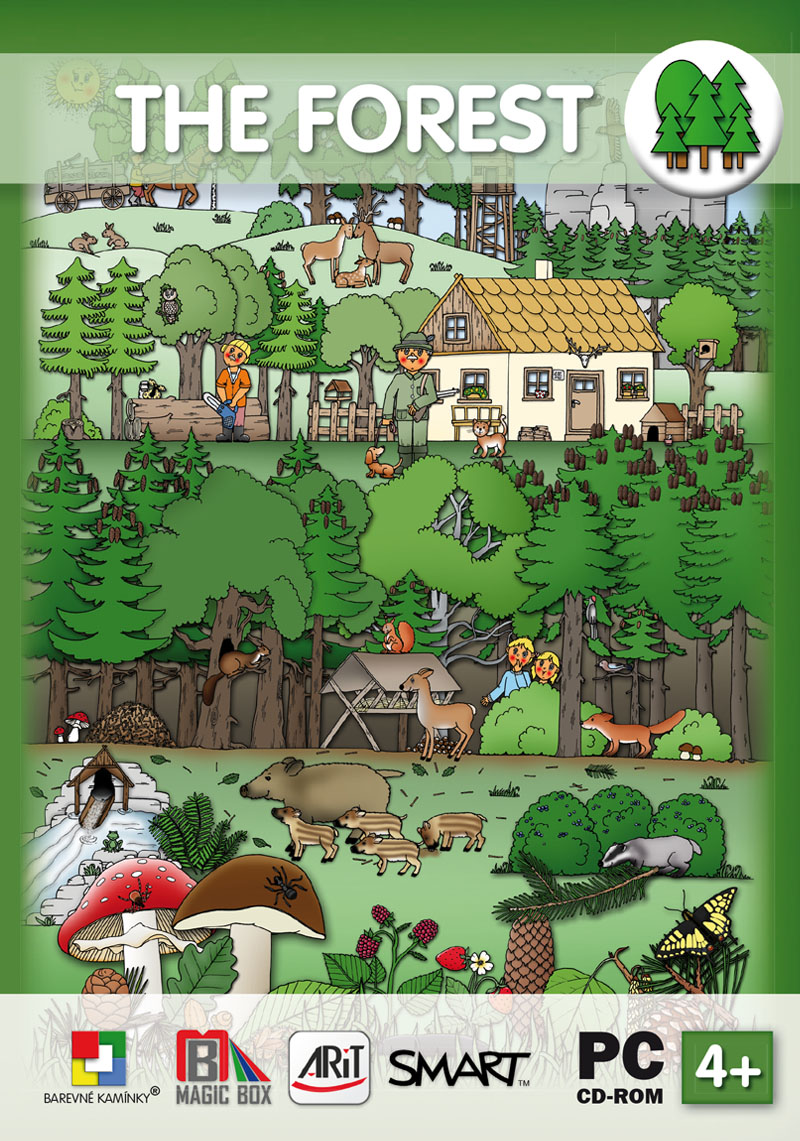The Forest
 INTERACTIVE PROGRAM FOR PRESCHOOL AND PRIMARY EDUCATION focusing on getting to know the forest environment and on appropriate and safe behaviour in the countryside.
INTERACTIVE PROGRAM FOR PRESCHOOL AND PRIMARY EDUCATION focusing on getting to know the forest environment and on appropriate and safe behaviour in the countryside.
135 interactive scenes
with tasks for developing hand and eye coordination, fine motor skills, knowledge of the basic principles of a healthy lifestyle, pronunciation and language skills, sensory perception, orientation in space and time, understanding basic numerical and mathematical terms, and working together during activities.
CONTENT OF THE ACTIVITY:
1. INTRODUCTION – initial scene of the FOREST with animated action, motivational story and melody.
2. CREATING A PICTURE – children talk about the picture of the forest. They can build a picture from individual pieces or from pictures of animals and forest fruits by dragging them onto a black and white or a coloured background. After correct completion of the task, a brief melody will be played.
3. GETTING TO KNOW THE FOREST – selection of trees, animals or fruits for recognition.
The picture of trees introduces the children to deciduous and coniferous trees, leaves, and fruits, their significance for people, and a brief description.
The picture of animals and fruits introduces individual animals and forest fruits to children with a brief description.
4. THE SQUIRREL’S TASKS – the squirrel offers tasks to children. After correct completion, a short melody is played and the squirrel runs to the scene and jumps up and down with happiness:
Numbers and counting – Maple samaras – counting 1 - 10 – the child assigns the number of samaras to the given number – Cones for the squirrel – The same – the child assigns the same number of cones - More or less than – the child assigns more or fewer cones for the squirrel – Penny bun mushrooms – the child moves the correct number of penny bun mushrooms for drying (addition) – Comparison, organization, and classification – From the tallest tree to the shortest and vice versa – the child organizes the trees according to their size – Odd one out – the child looks for and indicates those strawberries and toadstools which do not belong among the others – Pick the leaves and cones – the child assigns the leaves with flowers or fruits, or needles with pines to individual trees - Deciduous and coniferous trees – the child classifies the trees as deciduous and coniferous according to the symbols – Terms indicating sizes – Tall, short tree – the child assigns a short tree to the tall tree – Small, big tree – the child assigns a big tree to the small tree – Large, small – the child classifies leaves according to their size - Mazes “Ant” – the child must find the way out of the anthill - Mazes “Eggs in the anthill” – the child places ant eggs in the chambers – Colours and shapes – Leaves of the same colours and shapes – the child looks for leaves with the same colours and shapes – Make pairs – the child makes pairs from leaves of the same shape – Silhouettes of animals, fruits, and cones – the child looks for and assigns animals, fruits, and cones to their silhouettes - Alternate the cones – the child makes a pattern according to the template – All leaves of the same shape – the child assigns leaves of the same shape, various colours and sizes to a tree - Language and speech – What can you hear? - the child assigns letters to the beginning and end of the words according to the template - Antonyms – Opposite of large – the child assigns a small penny bun mushroom to the large penny bun mushroom – Opposite of full – the child fills an empty jug with strawberries – Opposite of day – the child pushes the darkness-button to introduce the night - Spatiotemporal orientation – Woodpecker in the tree – the child moves the woodpecker on the trees (up, down, from first to seventh – with clapping out or tapping a rhythm) – On the left, on the right, in front of and behind – the child practises spatial orientation by touching – Health and ecology – How can we protect ourselves from ticks – the child puts clothes on a girl and a boy for a walk in the forest and protects them with a repellent - Cleaning the forest – waste separation – a child cleans up the forest by separating waste into containers of the respective colours.
5. DRAWING – the program contains a drawing module with a palette of 13 colours and simple deletion (in part or in whole), where the child can draw freely or prepare him/herself for writing by drawing relaxation exercises for the wrist and shoulder. The child selects the desired colour by touching the colour palette and draws with a finger or a pen according to the type of interactive device.
6. MELODY MENU – the program contains melodies by Jaroslava Horáčková.
